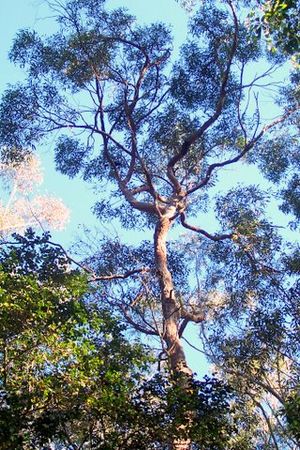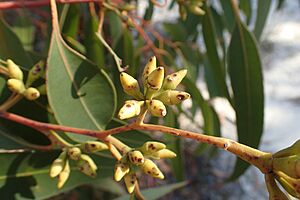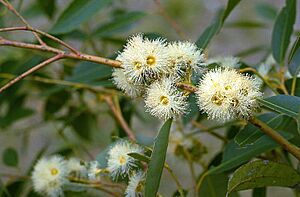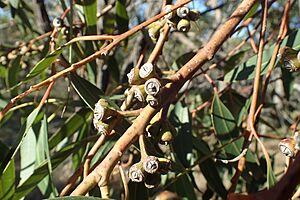Red mahogany facts for kids
Quick facts for kids Red mahogany |
|
|---|---|
 |
|
| Red mahogany at Chatswood | |
| Scientific classification | |
| Genus: |
Eucalyptus
|
| Species: |
resinifera
|
The Red Mahogany (scientific name: Eucalyptus resinifera) is a beautiful tree found only along the coast of eastern Australia. It's also sometimes called Red Messmate. This tree can grow quite tall and has rough, stringy bark that's reddish-brown. Its leaves are shaped like a spear, and its flowers are white, growing in small groups. After flowering, it produces woody, cup-shaped fruits.
Contents
What Does Red Mahogany Look Like?
The Red Mahogany is a medium to tall tree, often reaching up to 45 meters (about 148 feet) in height. It has a special woody swelling at its base called a lignotuber, which helps it regrow after fires.
Its bark is reddish-brown, rough, and feels stringy or fibrous. It peels off in long strips from the trunk and branches.
Leaves and Flowers
Young Red Mahogany plants have dull green leaves shaped like a spear, which are lighter on the underside. These leaves can be 6.5 to 15.5 centimeters (2.5 to 6 inches) long.
Adult leaves are dark, shiny green on top and paler underneath. They are also spear-shaped or slightly curved, growing 8 to 18 centimeters (3 to 7 inches) long. Each leaf has a stalk called a petiole that is about 1.5 to 2.5 centimeters (0.6 to 1 inch) long.
The tree's flower buds grow in groups of seven, nine, or eleven. Each group is on a stalk called a peduncle, which is 1 to 2.2 centimeters (0.4 to 0.9 inches) long. The individual buds are oval or spindle-shaped, 1 to 1.6 centimeters (0.4 to 0.6 inches) long, and have a cone-shaped or horn-shaped cap called an operculum.
Red Mahogany trees usually flower in December, and their flowers are white.
Fruit
After the flowers, the tree produces woody fruits. These fruits are shaped like a hemisphere, cone, or cup. They are 3 to 8 millimeters (0.1 to 0.3 inches) long and 6 to 10 millimeters (0.2 to 0.4 inches) wide. The parts that release the seeds (called valves) stick out strongly from the fruit.
How Red Mahogany Got Its Name
The Red Mahogany was first officially described in 1790 by a scientist named James Edward Smith. He wrote about it in a book called Journal of a Voyage to New South Wales. The tree was found near Port Jackson in Australia.
The scientific name resinifera comes from a Latin word meaning "resin-bearing," because the tree was thought to produce resin.
Different Types of Red Mahogany
In 1990, two scientists, Lawrie Johnson and Ken Hill, identified two slightly different types, or subspecies, of Red Mahogany:
- Eucalyptus resinifera subsp. hemilampra
- Eucalyptus resinifera subsp. resinifera
These two subspecies mainly differ in the length of their operculum (the cap on the flower bud).
Where Red Mahogany Grows
Red Mahogany trees are found along the coast of eastern Australia. You can see them from Nowra in New South Wales all the way up to Gladstone in Queensland. There are also some smaller, separate groups of trees even further north, up to Coen.
These trees prefer to grow in forests on flat areas, in valleys, and on gentle slopes. They like soils that are medium to highly fertile.
The subspecies hemilampra grows between Taree and Gladstone, while the subspecies resinifera is found between Nowra and Taree, and then again further north of Gladstone.
Wildlife and Red Mahogany
The Red Mahogany is an important tree for Australian wildlife. It serves as a food source for koalas, who enjoy eating its leaves.
Uses of Red Mahogany Wood
The wood from the Red Mahogany tree is highly valued for its excellent quality. It is very hard and heavy, with a beautiful dark-red inner wood called heartwood.
This strong timber is used for many things, including:
- Flooring in houses
- Panelling for walls
- Cladding on the outside of buildings
- Building boats
- Making railroad ties for train tracks
- General construction projects
It's also a good choice for making strong poles and charcoal.
Red Mahogany trees have even been planted in other parts of the world, like Africa (in Madagascar, South Africa, and Zimbabwe), Western Europe (Italy and Portugal), and the U.S. (Hawaiian Islands), for their valuable timber.
Images for kids





